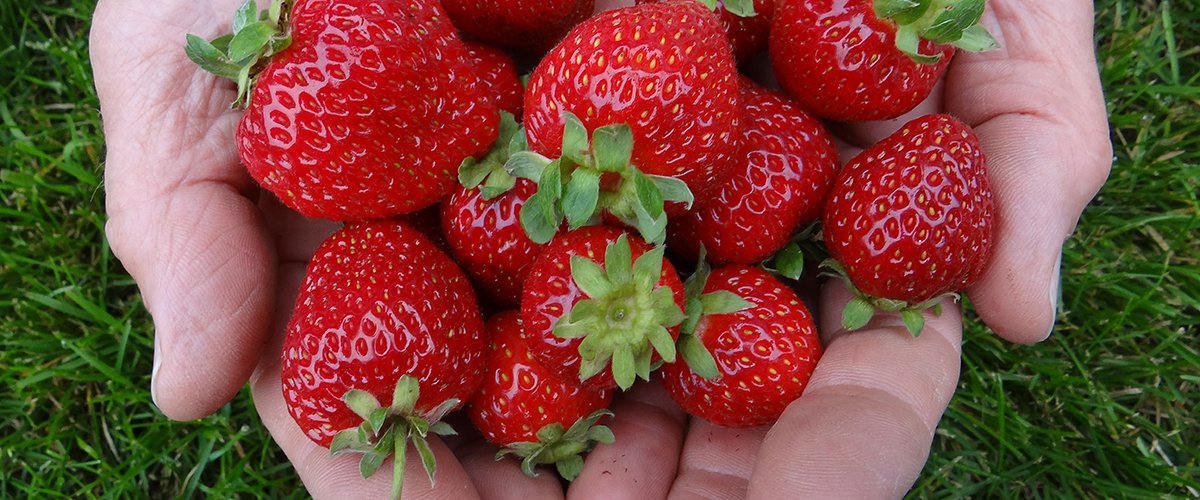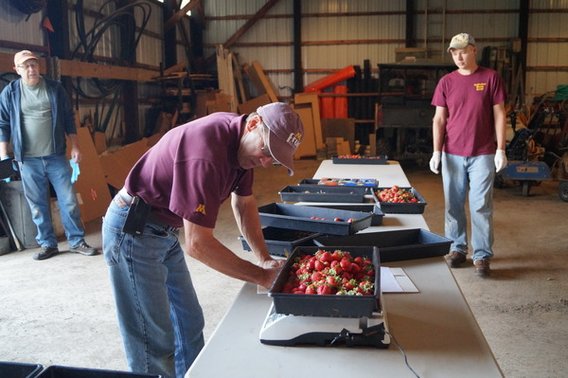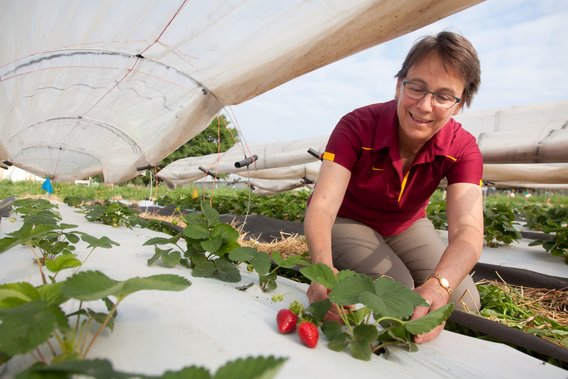
The science of Minnesota strawberries
50 years of U of M research bears fruitful insights and advancements

When it comes to fruit research, the University of Minnesota is best known for developing the Honeycrisp apple. However, the College of Food, Agricultural and Natural Resource Sciences' (CFANS) Department of Horticultural Science has a rich history of research into other fruits and berries, including apricots, plums, grapes, raspberries, currants, and strawberries. The strawberry research program has been particularly active, not only in creating new varieties, but also in the study of production practices that make this crop more resilient and profitable for growers.
Today, after more than 50 years of continuous study, U of M experts have developed strawberry varieties that thrive in the face of Minnesota’s challenging climatic conditions. In fact, if you take the temperature of Minnesotans’ healthy love of strawberries, you’ll discover that there is a rising demand for these horticultural crops.
Strawberries in Minnesota
The Minnesota growing season is generally characterized by short summers and long winters. But that doesn’t mean strawberries can’t succeed in the state. Strawberries are the fifth most popular fruit in the U.S., and Minnesotans have a strong affinity for them. As climate change starts to take effect, it is becoming increasingly important to understand how our crops will be affected.
The U of M is leading work to advance the way we grow strawberries in our ever-changing climate. We are now learning more than ever about how to better prepare the crop to survive in an environment with extreme weather, reduce some of the hazards brought on by climate change, and continue producing strawberries of the highest caliber. Despite the difficulties posed by climate change, we have discovered that strawberries can prosper in our environment provided we are prepared to use the finest growing methods, adjust to changing circumstances, and pursue sustainable agricultural practices.
“Adapting to a changing environment is essential for ensuring the success of our strawberry research. After 50 years of trial and error, our dedication to intensive research has provided us with the knowledge necessary to keep our strawberry production flourishing for years to come,” said Jim Luby, PhD, professor, Department of Horticultural Science.
Strawberries have a limited window of opportunity since they are susceptible to both heat and cold when growing, particularly in Minnesota, where the temperature has historically been colder. The U of M has conducted ongoing studies on two strawberry types over the years. June-bearing varieties are planted in the spring, and can be harvested the following year beginning in mid-June, but are usually done producing fruit by early July. Day-neutral strawberries are also planted in spring and bear fruit from July through October of the same year, or until the first killing frost, because of the protection of the low tunnel system. June-bearing varieties overwinter, while day-neutrals are best grown as an annual in our climate.
Luby — with Emily Hoover, PhD, professor and head of the Department of Horticultural Science; and Nate Dalman and Steve Poppe of the U of M’s West Central Research and Outreach Center (WCROC) in Morris, Minnesota — examined how well newly released strawberry cultivars and top picks from the University’s breeding program adapt to Minnesota’s environment at the WCROC. Since 1982, the WCROC has been conducting ongoing studies on varieties of strawberries that have been tried and proven for more than 50 years and are farmed all over North America.

Some growing challenges
The U of M’s strawberry trials continue to experience one of their biggest issues as a result of climate, which poses significant challenges for Minnesota’s strawberry industry. For example, prolonged periods of high temperatures in summer months could damage vulnerable crop varieties and cause a decrease in overall production. Alternatively extreme weather conditions including intense rainfall, prolonged winters, drought, and increased ultraviolet exposure can cause issues with the growing of day-neutral strawberries. Other particular challenges at the WCROC include the high pH soils and severe summer storms prevalent in the western part of the state.
To determine the best method for growing strawberries, researchers investigated a range of cultivars and growing systems including low-tunnels, soilless gutters, as well as mulch and plasticulture systems. Low tunnels are used in agriculture to protect crops from adverse weather conditions and extend the growing season. In strawberry production, they are typically made of a series of hoops, covered with a protective material. Plasticulture systems are agricultural production practices that use plastic materials to improve crop production.
The WCROC started experimenting with the use of low tunnels on day-neutral strawberry cultivars in 2013. The study looked at how the tunnels extended the strawberry growth season by providing a mini-greenhouse environment above each strawberry row. When the outdoor temperature drops, the low-tunnel can provide a warming effect for the plants. The tunnels also protected the plants from hail and wind damage.
The well-known strawberry research team has dedicated more than 100 cumulative years to building a bright future for Minnesota strawberry farmers. Their expertise has paved the way for a number of strawberry-growing methods that Minnesotan farmers can use to generate consistent, high-quality crops. In order to address the growing problems of climate change, disease and pest pressure, and soil nutrient depletion, ongoing attention to being on the cutting edge of the rapidly evolving field of agriculture research is required.
Sustainable sweetness
It’s clear that strawberries will continue to be a popular part of diets in the United States. U.S. Department of Agriculture statistics show the country produced nearly 1.34 million tons of strawberries in 2021, and according to the Minnesota Department of Agriculture, there are more than 90 “Minnesota Grown™” strawberry farmers right here in the state.
Andy Petran PhD, who pursued his PhD with Hoover at CFANS and is now a strawberry grower at Twin Cities Berry Co. in Farmington, Minnesota, is confident in the future for farmers of this beloved berry. “I believe that through careful research and trial, we can make farming more accessible by protecting our crops and expanding our growing seasons,” said Petran. “It’s an investment in all of our futures and the future of farming in Minnesota.”

His former instructor, Hoover, concurs. “By continuing to push the limits, strawberries have demonstrated their undying dedication to providing us with an abundance of nutrition and sweetness, even in the face of fluctuating weather and constantly shifting climates. By applying clever, sustainable growing practices and meticulous research, we can help ensure their longevity in the face of climate change,” she said.
For 50 years, the U of M has been devoted to understanding and expanding the progress of strawberry varieties that thrive in the face of Minnesota’s challenging climatic conditions. These efforts have resulted in delicious berries that bring nourishment and joy to all and ensure the berries’ longevity. Researchers, farmers, and consumers alike can be thankful for the delicious bounty of Minnesota’s beloved strawberry and look ahead to a bright and berry-filled future — for Minnesota and beyond.





